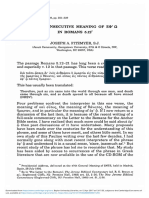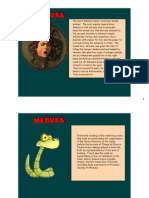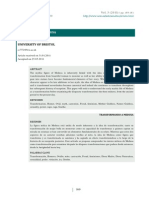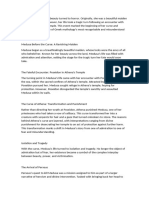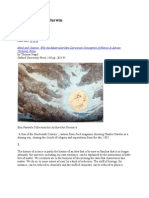Medusapaper
Medusapaper
Uploaded by
api-293988866Copyright:
Available Formats
Medusapaper
Medusapaper
Uploaded by
api-293988866Original Title
Copyright
Available Formats
Share this document
Did you find this document useful?
Is this content inappropriate?
Copyright:
Available Formats
Medusapaper
Medusapaper
Uploaded by
api-293988866Copyright:
Available Formats
Sparks 1
Natalya Sparks
Sabot
English II
20 September 2015
The Portrayal of Medusa
Medusa is one of three Gorgons. They are all sisters but Medusa is the only one who was
mortal. Medusa was a beautiful girl until Poseidon raped her in a temple of Athene. The goddess
became angry at the violation of the holiness of her temple and turned Medusa into a hideous
monster. Perseus later killed her (Medusa). From the earliest Greek myths, Medusa has been a
monster (Root). However, in more recent times, Medusa has come to be celebrated, and even
embraced. Throughout time, Medusa has been portrayed in different ways.
The most classic portrayal of Medusa is that of her being a monster who turns anyone
who looked at her into stone. She is covered with impenetrable scales and has snakes crowning
her head rather than hair. She also often appears with a snout, tusks, and horns or wings. By
some, her blood is believed to have created the coral reef of the red sea and all of the snakes in
Africa by others (Medusa in Myth and Literary History). Because of Poseidon, Medusa had two
children, Pegasus, the winged horse, and Chrysaor, father of the monster Geryon, who both
sprang out of her body when she was killed. When Medusa was killed, Perseus cut off her head,
which retained its power, and used it to turn his enemies into stone.
In the 5th century B.C., Medusa was portrayed as beautiful and as an innocent victim of
Poseidons actions. She is more normal, with her only non-human features being wings. This lets
the audience sympathize with her more. They can also sympathize more with this version
because Medusas sisters are a bigger part of this myth, and they are told to have mourned the
Sparks 2
death of their beloved sister. This version is told with Athena being jealous of Medusa or with
Perseus cutting off her head so he never has to be away from it (Wallace). Ovid stated that she
was irresistible to whoever encountered her (Mancini). Some have celebrated her charm and the
beauty of her hair (Medusa in Myth and Literary History).
Medusa can also represent female fury. Feminists have used her face as a symbol of their
own rage in a world of physical violence against women and patriarchy. From Medusa we can
learn how to show ourselves in a way that repels men when necessary. She teaches life-saving
information about fury (The Medusa Reader). Her rage is in everyone. If people use it, it can be a
source of strength (Orodenker). Many people are actually attracted to her rather than repelled.
Yet another portrayal is Medusa being an embodiment of power, whether she is dead or
alive. This can be seen in many different stories. For example, when Medusa died, Athena saved
some of her blood and gave it to Asclepius, the god of healing. Blood from her left side was
deadly but blood from her right side could bring the dead back to life (Glenn). Even in some
Greek cultures, Medusa was not seen as a monster. Instead, her and her three sisters were
worshiped as protective demons who scared evil spirits away from the community (Medusa).
After Medusa died, anyone who looked at her would be turned to stone. It was for this reason
that Greeks often had her image on their armor (Medusa, in Greek Mythology).
The interpretation of Medusa's story depends on the culture and experiences of the person
hearing it. It shows what they value or believe in. To the Greeks, Medusa was a monster. This
shows how rape was more common and acceptable in Greek culture, and how they took a man's
word over a woman's, because Medusa was punished for being raped, and they took Poseidon's
word over Medusas. Medusa being beautiful or representing power shows how these things are
no longer tolerated, and possibly how your mistakes dont have to define your future, and how
Sparks 3
your flaws don't define you or your life, because Medusa being turned into and looking like a
monster doesnt mean that she is all bad. Medusa has been portrayed differently throughout time,
and will be again in the future.
Works Cited
Glenn, Justin M. "Medusa." World Book Online. N.p., n.d. Web. 16 Sept. 2015.
Mancini, John. "Pursuing the Gorgon Medusa." Classical Wisdom Weekly. N.p., 16 July
2014. Web. 17 Sept. 2015.
Sparks 4
"Medusa." Infobase Learning. Facts on File, 2015. Web. 16 Sept. 2015.
"Medusa, in Greek Mythology." EBSCOhost. N.p., n.d. Web. 16 Sept. 2015.
"Medusa in Myth and Literary History." Modern American Poetry. N.p., n.d. Web. 18 Sept.
2015.
Orodenker, Judith. "The Voice of the Goddess: The Reemergence of the Archetypal Divine
Feminine." Google Books. N.p., n.d. Web. 17 Sept. 2015.
Root, Ileen Brennan. "Redeeming the Gorgon: Reclaiming the Medusa Function of Psyche."
Google Books. N.p., n.d. Web. 17 Sept. 2015.
The Medusa Reader." Google Books. Ed. Marjorie Garber and Nancy J. Vickers. N.p., n.d.
Web. 17 Sept. 2015.
Wallace, Sarah Bernice. "The Changing Faces of Medusa." Reinvention: An International
Journal of Undergraduate Research. N.p., n.d. Web. 18 Sept. 2015.
You might also like
- Boehm, Omri - The Binding of Isaac. A Religious Model of DisobedienceDocument160 pagesBoehm, Omri - The Binding of Isaac. A Religious Model of DisobedienceFlip100% (3)
- Bible Trivia Questions and AnswersDocument14 pagesBible Trivia Questions and AnswersLim Wee LekNo ratings yet
- Fitzmyer - The Consecutive Meaning of Eph W in Romans 5.12Document19 pagesFitzmyer - The Consecutive Meaning of Eph W in Romans 5.12kansas07100% (6)
- What Jesus Said. by H. M. S. Richards. Author Of. Day After Tomorrow. The Indispensable Man. The Promises of God. Revival SermonsDocument202 pagesWhat Jesus Said. by H. M. S. Richards. Author Of. Day After Tomorrow. The Indispensable Man. The Promises of God. Revival SermonsrobertblaisNo ratings yet
- FOSTER, Hal, Medusa and The RealDocument11 pagesFOSTER, Hal, Medusa and The RealDaniel LesmesNo ratings yet
- 3 EL 112 - Pandora and MedusaDocument4 pages3 EL 112 - Pandora and MedusaAngel RodriguezNo ratings yet
- The Myth of MedusaDocument6 pagesThe Myth of MedusaLaura FodorNo ratings yet
- MedusaDocument8 pagesMedusapierrette1No ratings yet
- Guardians of Darkness - The Gorgon MedusaDocument14 pagesGuardians of Darkness - The Gorgon Medusaaccime24100% (1)
- Peace Through Spiritual Discipline by Gurudev Bawra Ji MaharajDocument16 pagesPeace Through Spiritual Discipline by Gurudev Bawra Ji MaharajBRGRSNo ratings yet
- Christian Leadership PDFDocument83 pagesChristian Leadership PDFluckywaysNo ratings yet
- Aims and Claims-Anthony BuzzardDocument262 pagesAims and Claims-Anthony BuzzardRachel ZRNo ratings yet
- Joys of Christmas Songbook 2013Document15 pagesJoys of Christmas Songbook 2013cn_cadillacmi21% (14)
- Med UsaDocument4 pagesMed UsaElvis LeonNo ratings yet
- Greek Mythology Research Annotated BibliographyDocument2 pagesGreek Mythology Research Annotated Bibliography108627No ratings yet
- Medusa UntoldDocument2 pagesMedusa UntoldElijah Loh Keng SoonNo ratings yet
- Transforming MedusaDocument13 pagesTransforming Medusasegu82No ratings yet
- Final Annotated BibliographyDocument10 pagesFinal Annotated Bibliographyapi-669030867No ratings yet
- Medusa The Victimized Monster PDFDocument5 pagesMedusa The Victimized Monster PDFAdonai Jireh Dionne BaliteNo ratings yet
- Medusa Other SideDocument19 pagesMedusa Other SideCaesarRRZNo ratings yet
- The Rape of Medusa. Feminist RevisionDocument13 pagesThe Rape of Medusa. Feminist RevisionabronouraNo ratings yet
- Literature Review Final Jedidiah SokohDocument8 pagesLiterature Review Final Jedidiah Sokohapi-669030867No ratings yet
- Asiye AminayiDocument7 pagesAsiye Aminayihosen.ghiyasi77No ratings yet
- Medusa - WikipediaDocument1 pageMedusa - Wikipediacsdeleonardo187No ratings yet
- Medea Feminism and The ShadowDocument21 pagesMedea Feminism and The Shadowapi-305429806No ratings yet
- The Misunderstood Identity of Medusa: M.A English Literature, Pachaiyappas College, Chennai-30Document1 pageThe Misunderstood Identity of Medusa: M.A English Literature, Pachaiyappas College, Chennai-30racheal daphne manuelNo ratings yet
- The Ferocious and The Erotic: "Beautiful" Medusa and The Neolithic Bird and SnakeDocument19 pagesThe Ferocious and The Erotic: "Beautiful" Medusa and The Neolithic Bird and SnakeMilo SelasNo ratings yet
- Medusa: Suleman Touray 4C EsoDocument4 pagesMedusa: Suleman Touray 4C EsoSulemanNo ratings yet
- MedusaDocument4 pagesMedusagabby rielleNo ratings yet
- Caput AlgolDocument14 pagesCaput AlgolRaphael888100% (3)
- The Curse of MedusaDocument2 pagesThe Curse of MedusaRichelle Anne TecsonNo ratings yet
- The Myth of Perseus and Medusa PDFDocument2 pagesThe Myth of Perseus and Medusa PDFAli GonzálezNo ratings yet
- Medea Complete PDFDocument109 pagesMedea Complete PDFSyamin Azhar67% (3)
- Daughter of GraceDocument1 pageDaughter of Graceaverysam100No ratings yet
- medusa and the realDocument11 pagesmedusa and the realRúben SantosNo ratings yet
- Medusa - Wikipedia, The Free EncyclopediaDocument7 pagesMedusa - Wikipedia, The Free Encyclopediaariman5678582No ratings yet
- Greek MythsDocument3 pagesGreek Mythssdea21nNo ratings yet
- Allusion 9Document1 pageAllusion 9api-224492732No ratings yet
- Essay - MythologyDocument6 pagesEssay - MythologyMeehawNo ratings yet
- MedusaDocument2 pagesMedusaEmaNo ratings yet
- Medusa. Texto Aula Giovana Ruiva 12.11Document2 pagesMedusa. Texto Aula Giovana Ruiva 12.11Martha GattarosaNo ratings yet
- MedusaDocument1 pageMedusaDavidva21No ratings yet
- The Greco Roman Medusa and Her NeolithicDocument20 pagesThe Greco Roman Medusa and Her NeolithicArianna DrudiNo ratings yet
- The Beauty and Horror of Medusa, An Enduring Symbol of Women's PowerDocument6 pagesThe Beauty and Horror of Medusa, An Enduring Symbol of Women's PowerandylucasNo ratings yet
- Priyansh Kansara Medusa AnalysisDocument5 pagesPriyansh Kansara Medusa AnalysisPriyansh KansaraNo ratings yet
- Final Paper Cams 45h-2Document10 pagesFinal Paper Cams 45h-2api-743769951No ratings yet
- Dangerous Beauty Medusa in Classical ArtDocument52 pagesDangerous Beauty Medusa in Classical ArtPriscila ZaidanNo ratings yet
- Folktale Project ExampleDocument9 pagesFolktale Project Exampleapi-625209447No ratings yet
- FengDocument25 pagesFengAmedeo FeraNo ratings yet
- Medusa in Classical ArtDocument52 pagesMedusa in Classical ArtJessila100% (1)
- Edmunds Helen'sDivine OriginsDocument45 pagesEdmunds Helen'sDivine Originsbanbha100% (1)
- The GraeaeDocument5 pagesThe GraeaeSabrina Carlisle ReichleNo ratings yet
- Untitled DocumentDocument7 pagesUntitled DocumenthannhNo ratings yet
- The Greek MythsDocument9 pagesThe Greek Mythskarlaepz08091No ratings yet
- The Greek MythsDocument9 pagesThe Greek Mythskarlaepz08091No ratings yet
- Women and Other Monsters: Building a New MythologyFrom EverandWomen and Other Monsters: Building a New MythologyRating: 4 out of 5 stars4/5 (28)
- Myths Derived From Scripture & Myths As Explanations of Natural Phenomena (FINAL TERM)Document9 pagesMyths Derived From Scripture & Myths As Explanations of Natural Phenomena (FINAL TERM)KatieOcampoNo ratings yet
- Ib DP English Medea Vs Awakening Compare 0 ContrastDocument5 pagesIb DP English Medea Vs Awakening Compare 0 ContrastYesha Shah CherubsNo ratings yet
- Lovers of Greek Gods and Goddesses: And Some Other Love Stories from Greek MythologyFrom EverandLovers of Greek Gods and Goddesses: And Some Other Love Stories from Greek MythologyNo ratings yet
- TextDocument1 pageTextms.makaylacelineNo ratings yet
- HomerDocument8 pagesHomeranvikshasingh583No ratings yet
- Carol Ann DuffyDocument4 pagesCarol Ann DuffyNesreen YusufNo ratings yet
- Context: Carol Ann Duffy and Medusa'Document2 pagesContext: Carol Ann Duffy and Medusa'diyaaNo ratings yet
- ENG 431 Research PaperDocument10 pagesENG 431 Research PaperTasnimNo ratings yet
- AnswerDocument2 pagesAnswerKasnhaNo ratings yet
- 1878 - Leo XiiiDocument16 pages1878 - Leo XiiiCLEOFAS MSOFE (Rua Mangi)No ratings yet
- Damodara Ashatkam (Sanskrit and Tamil Transliteration With English Translation)Document16 pagesDamodara Ashatkam (Sanskrit and Tamil Transliteration With English Translation)vlaxmananNo ratings yet
- October 31st Day of The National Coat of Arms of EcuadorDocument6 pagesOctober 31st Day of The National Coat of Arms of EcuadorScribdTranslationsNo ratings yet
- Nt30 TeensDocument15 pagesNt30 TeensPamela Palomino BecerraNo ratings yet
- Apocrypha Are Works, Usually Written Works, That Are of Unknown Authorship, or of DoubtfulDocument4 pagesApocrypha Are Works, Usually Written Works, That Are of Unknown Authorship, or of DoubtfulJas PalNo ratings yet
- Awaiting A New DarwinDocument10 pagesAwaiting A New DarwinzizekNo ratings yet
- 30 President Monson QuotesDocument3 pages30 President Monson QuotesJocelyn Hatch ChristensenNo ratings yet
- Ika-29 NG Hunyo - Martes I-Dakilang Kapistahan Nina San Pedro at San PabloDocument24 pagesIka-29 NG Hunyo - Martes I-Dakilang Kapistahan Nina San Pedro at San PabloEgbertDizonNo ratings yet
- The Mystic Messenger, September 1935Document12 pagesThe Mystic Messenger, September 1935sauron385100% (2)
- Importance of Obedience To Nizam e Jamaat 20091226Document8 pagesImportance of Obedience To Nizam e Jamaat 20091226iftisweltNo ratings yet
- Bible Interpretations and Explanation II Missing PagesDocument57 pagesBible Interpretations and Explanation II Missing Pageslathamdavid9100% (6)
- By The Philippine Tourism Promotions Board: The People of The PhilippinesDocument1 pageBy The Philippine Tourism Promotions Board: The People of The PhilippinesRobert Kier Tanquerido TomaroNo ratings yet
- 10 - Advice To YouthDocument3 pages10 - Advice To Youthapi-309434036No ratings yet
- Theotokos: The Ascension of Jesus ChristDocument2 pagesTheotokos: The Ascension of Jesus ChristachasaballaNo ratings yet
- The Historiography of New France and The Legacy of Iroquois InternationalismDocument19 pagesThe Historiography of New France and The Legacy of Iroquois InternationalismbasquitjNo ratings yet
- Comparison of Sociologies of Karl MarxDocument4 pagesComparison of Sociologies of Karl MarxDavid Carlos Romero Servado100% (1)
- Deacons in Early ChurchDocument2 pagesDeacons in Early ChurchBrince MathewsNo ratings yet
- Tuikual Branch KTP Chanchin (1961 - 2011)Document16 pagesTuikual Branch KTP Chanchin (1961 - 2011)tuikualktpNo ratings yet
- Chicken of The SeaDocument3 pagesChicken of The SeaNickNorelliNo ratings yet
- Invitation-2020 Church HarvestDocument14 pagesInvitation-2020 Church HarvestEdward OtempongNo ratings yet
- Sermon 9.18.2021 (Useful in God's Kingdom)Document7 pagesSermon 9.18.2021 (Useful in God's Kingdom)Met Malayo100% (1)
- SUNDAY MATINS HYMNS - Tone - 6 - Plagal 2 - 25 Sept 2011 - 15 AP - 1 Luke - ST EuphrosyneDocument8 pagesSUNDAY MATINS HYMNS - Tone - 6 - Plagal 2 - 25 Sept 2011 - 15 AP - 1 Luke - ST EuphrosyneMarguerite PaizisNo ratings yet


